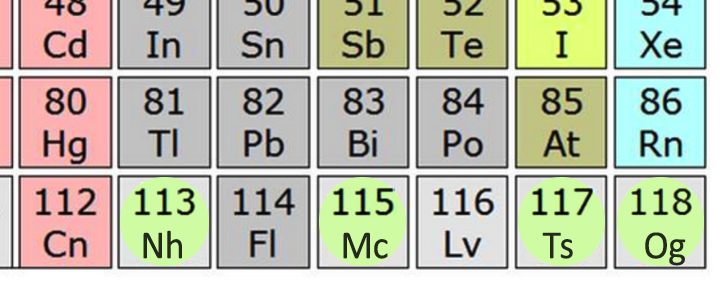The Four New Elements are Named
The Four New Elements are Named
Released 8 June 2016
The four newly discovered elements now have proposed names: nihonium (atomic number 113), moscovium (atomic number 115), tennessine (atomic number 117), and oganesson (atomic number 118). The discovery of these elements was confirmed earlier this year by the IUPAC/IUPAP Joint Working Party [1,2] and now the names have been announced by the International Union of Pure and Applied Chemistry (IUPAC) on 8 June 2016 (http://iupac.org/news/). The groups responsible for the discovery were invited to submit names that follow the recently revised rules for the naming of elements [3]. The proposed names were then reviewed by the IUPAC Inorganic Chemistry Division, which has recommended their acceptance. After a public comment period of five months (see http://iupac.org/recommendations/under-review-by-the-public/ ) the names will be approved and the results will be published in Pure and Applied Chemistry.
Element 113: Nihonium (with the symbol Nh) was named using one of the Japanese names for Japan, Nihon (the land of the rising sun). The discovery was made at the RIKEN Nishina Center for Accelerator Science in Japan. The collaboration bombarded a bismuth target with a zinc-70 beam using the RIKEN heavy-ion facility in Japan. The new element, nihonium decayed to known lighter elements by alpha-decay, which allowed it to be identified.
Element 115: Moscovium (with the symbol Mc) was named after the Moscow region, the location of the Joint Institute for Nuclear Research in Dubna, Russia. The JINR used the heavy ion accelerator facilities of the Flerov Laboratory and their gas filled recoil separator to do experiments in collaboration with researchers from the Lawrence Livermore National Laboratory, Oak Ridge National Laboratory, and Vanderbilt University in the USA. The element moscovium was produced by bombardment of targets of americium by calcium-48 ions.
Element 117: Tennessine (with the symbol Ts) was named after the US state of Tennessee. The name recognizes the contribution of the Oak Ridge National Laboratory and Vanderbilt University in that state to the discovery of the element tennessine, as well as the long standing contributions of those institutions and the University of Tennessee to the production of new elements. Tennessine was produced by the bombardment targets of berkelium by calicium-48 ions at the JINR. The rare berkelium target was produced at the high-flux reactor at Oak Ridge National Laboratory.
Element 118: Oganesson (with the symbol Og) was named after the nuclear physicist Professor Yuri Oganessian. Professor Oganessian led Dubna research into super-heavy nuclei and the search for new elements, including the element oganesson. It is fitting that the collaboration of the Joint Institute for Nuclear Research in Dubna, Russia and the Lawrence Livermore National Laboratory, USA, which produced oganessian by bombardment of a californium target by the calicium-48 beam chose to name the element after him.

Element 113: Nihonium (with the symbol Nh) ; Element 115: Moscovium (with the symbol Mc) ; Element 117: Tennessine (with the symbol Ts) ; Element 118: Oganesson (with the symbol Og)
The new elements complete the seventh row of the periodic table. Whether or not the periodic table has an end is not known and the chemical and physical properties of these extreme elements and their isotopes are yet to be discovered.
Laboratories are already working on searches for the elements in the 8th row for the periodic table, and they are also working to consolidate the identification of copernicium and heavier elements. To be able to evaluate this work, IUPAC and IUPAP are currently reviewing the selection principle and operations of a future Joint Working Party (JWP) and as soon as these principles have been decided a new group will be formed. This new JWP will review new claims and the consistency of new results with those already evaluated by earlier JWPs.
References:
1) P.J. Karol et al., Pure & Applied Chemistry, Feb 2016, Vol. 88 Issue 1/2, p139-153, DOI: 10.1515/pac-2015-0502.
2) P.J. Karol et al., Pure & Applied Chemistry, Feb 2016, Vol. 88 Issue 1/2, p155-160, DOI: 10.1515/pac-2015-0501.
3) W.H. Koppenol et al., Pure & Applied Chemistry, Apr 2016, Vol. 88 Issue 4 p 401-405, DOI: 10.1515/pac-2015-0802.
For further information contact Bruce McKellar, President of IUPAP, at bhjmckellar@mac.com.
Background information about IUPAP is available on its webpage at http://archive2.iupap.org/about-us/
 IUPAP: The International Union of Pure and Applied Physics
IUPAP: The International Union of Pure and Applied Physics